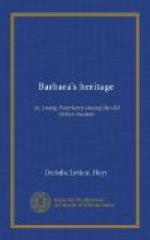“You have read much of Raphael’s life, so I will not talk about that. You remember that, when young, he studied in Perugia, in Perugino’s studio, and perhaps you will recollect that, when we were there, I told you that his early work was exceedingly like that of this master.
“Now, look! Here right before us is Raphael’s Coronation of the Virgin,—his first important painting. See how like Perugino’s are the figures. Notice the exquisite angels on either side of the Virgin, which are so often reproduced! See their pure, childlike faces and the queer little stiffness that is almost a grace! See the sweet solemnity of Christ and the Madonna, the staid grouping of the figures below,—the winged cherubim,—the soft color!
“I have here two photographs,” and he unfolded and passed one to Margery, who was close beside him, “which I wish you to look at carefully. They are of works painted very soon after the Coronation; one, the Marriage of the Virgin, or Lo Sposalizio, is in the Brera Gallery at Milan. It is as like Perugino’s work as is the Coronation.”
After a time spent in looking at and talking about the picture, during which Bettina told the story of the blossomed rod which Joseph bears over his shoulder, and the rod without blossoms which the disappointed suitor is breaking over his knee, Mr. Sumner gave them the other photograph.
“This,” he resumed, “you will readily recognize, as you have so often looked at the picture in the Pitti Gallery in Florence—the Madonna del Gran Duca. This is the only Madonna that belongs to this period of Raphael’s painting, and the last important picture in the style. It was painted during the early part of his visit to Florence.”
“I never see this, uncle,” said Margery, as she passed the photograph on to the others, “without thinking how the Grand Duke carried it about in its rich casket wherever he went, and said his prayers before it night and morning. I am glad the people named it after him. Don’t you think it very beautiful, uncle?”
“Yes; and it is one of the purest Madonnas ever painted—so impersonal is the face,” replied Mr. Sumner.
“I wish,” he continued, “I could go on like this through a list of Raphael’s works with you, but it is utterly impossible, so many are there. When he went to Florence, where you know he spent some years, he fell under the influence of the Florentine artists, and his work gradually lost its resemblance to Perugino’s. It gained more freedom, action, grace, and strength of color. Some examples of this second style of his painting are the Madonna del Cardellino, or Madonna of the Goldfinch, which you will remember in the Uffizi Gallery, Florence, and La Belle Jardiniere in the Louvre, Paris. But I have brought photographs of these pictures so that you may see the striking difference between them and those previously painted.”




